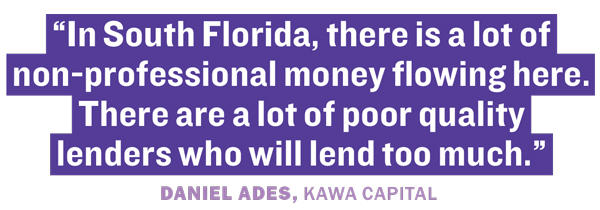Miami’s condo doomsday prognosticator, Peter Zalewski, has been waiting for this moment for almost a decade.
The fast-talking former business journalist turned consultant with a penchant for electronic cigarettes and condo sales numbers has predicted the crash of Miami’s high-end condo market for years.
Zalewski projects that, driven by an oversupply of expensive condo buildings in Miami Beach and downtown Miami, along with a new influx of luxury apartments, vulture funds will swoop in to buy the units for pennies on the dollar. Luxury apartments won’t get leased due to the large number of condos that are being rented out, adding to the overall rental inventory.
“You are going to get a lot of spin on how everything is great, trying to build up the perception of demand, but anecdotally, if you look around, there is a rental building just west of downtown that is offering three months of rent free,” said Zalewski.
READ MORE IN THIS SERIES:
His company, Condo Vultures, analyzes sales numbers to back these predictions up. According to Zalewski, there is a five-year oversupply of luxury condos in downtown Miami alone. Reports by other brokerages, however, contend that while there is a lot of supply, much of it is being absorbed. ISG’s Miami Report, published in May, calculated that there are 20,000 units in the pipeline this cycle, from Coconut Grove to Fort Lauderdale and east of I-95, with a total of 89 percent that have been pre-sold.
 In the last cycle, parts of South Florida’s real estate market imploded. Buyers of high-end condo projects fled; for example, at the 103-unit “Caribbean” condominium complex in Miami Beach, only 14 buyers sought to close. Developers were forced into heavy losses or bankruptcy.
In the last cycle, parts of South Florida’s real estate market imploded. Buyers of high-end condo projects fled; for example, at the 103-unit “Caribbean” condominium complex in Miami Beach, only 14 buyers sought to close. Developers were forced into heavy losses or bankruptcy.
It’ll be a different kind of ride through a downturn today versus 2008, according to industry professionals, who argue that more precautions have been taken to mitigate losses.
But there will still be winners and losers. Poised to take the winning side are vulture funds such as Miami-based Safe Harbor Equity and Bain Capital, which will capitalize on defaulted loans and buyers looking to get rid of their condo units. On the losing side, there will be some overleveraged developers, of course, as well as debt and equity lenders who don’t get paid back.
Cracks in the market
In South Florida, there have been a unique set of recession warning signs. Residential foreclosure lawsuits were up 7 percent in the first half of 2019, compared to the first half of 2018, to 10,258, according to Attom Data Solutions. During this same time, new foreclosure filings increased 32 percent, to 5,663.
Ralph Serrano of Safe Harbor Equity, whose fund is currently seeking to raise $200 million to buy distressed debt in South Florida and throughout the country, said he is seeing growing signs of distress in the tri-county area.
“I am seeing an increase in defaults on the bank level in terms of borrowers not making the payments in a timely fashion,” he said.
Serrano added that he’s also seeing issues with some buyers in countries such as Venezuela that are having difficulty getting money out of the country.
Daniel Ades of Kawa Capital, a Miami-based firm with $1.2 billion in assets under management, said he has already completed two bulk condo deals in Miami in the past four months. The company bought units in two separate high-end condo projects for about a 30 to 50 percent discount from the previous sale price. He declined to give the names of the projects but added that more of these type of bulk condo deals could be coming soon.
In Sunny Isles Beach, the developers of the Regalia luxury condo tower were recently forced to turn over 100 percent interest in the two remaining — and most expensive — unsold units by a Miami-Dade County Judge after the development group failed to pay a $3 million judgment.
And just north of Miami in Hollywood, Madison Realty Capital is currently seeking foreclose on $40.06 million of delinquent debt of Costa Hollywood Beach Resort at 777 North Ocean Drive, which opened only a year ago.

Nonbank lending’s increasing popularity
The emergence of nonbank lenders and alternative financing is one factor that makes this potential recession look different from the last. Since the last downturn, banks have backed away from commercial real estate lending due to increased regulatory scrutiny under the Dodd-Frank Wall Street Reform and Consumer Protection Act.
Nonbanks have stepped in to fill the void and, as a result, mezzanine lending, which was popular prior to the recession, is making a comeback.
Generally used to fill in the gaps on construction loans for large-scale projects, mezzanine loans are a hybrid of equity and debt. Mezzanine lenders most often get paid back after the senior loan, and the rate is between 12 and 20 percent per year, which is much higher than traditional financing.
“I am seeing more mezzanine right now due to interest rates and banks backing away,” said Jay Sakalo, a partner at Bilzin Sumberg in Miami, whose team negotiated financing for PTM Partners and Estate Investments Group’s mixed-use project Soleste Grand Central in Miami’s Overtown neighborhood. The capital stack included $18 million in mezzanine financing from Nationwide Real Estate Investments and a $55 million construction loan from Bank OZK.
The inherent risk lies in the fact that mezzanine lenders are generally paid back after the construction loan is paid off. If a developer runs into trouble, there is a chance that the mezzanine lender won’t get paid back right away or at all.
“I think there are some mezzanine lenders that got uber aggressive and they may very well own the project,” said Brett Forman of Boynton Beach-based Trez Forman Capital, a nonbank lender.
That’s what happened in New York City, where an 88-story luxury apartment building, 125 Greenwich, could be taken over by Jupiter, Florida-based United States Immigration Fund, which provided a $194 million mezzanine loan to the project’s sponsors in 2017. USIF, which raises its money through the EB-5 visa program, is now seeking to foreclose upon the project.
Another potential risk is the growing use of non-recourse lending by nonbanks.
“Alternative lenders are growing because banks are predominantly [providing loans at] full recourse,” according to Charles Penan of Aztec Group, a real estate investment and merchant banking firm.
There is also more risk in nonbank financing because there is less publicly available information known about nonbank lenders. They aren’t required to hold the same amount of capital as banks since they are not subject to the same level of regulation.
“In South Florida, there is a lot of non-professional money flowing here,” said Kawa Capital’s Ades. “There are a lot of poor quality lenders who will lend too much.”
